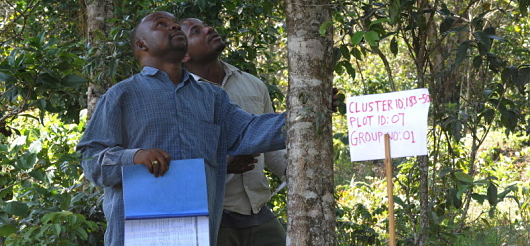Criteria and indicators (C&I) are tools for defining, guiding, monitoring and assessing progress towards SFM in a given context. The overall aim of C&I is to promote SFM, taking into consideration the social, economic, environmental, cultural and spiritual needs of stakeholders. Criteria are categories of conditions or processes by which SFM can be assessed, and each criterion is characterized by a set of indicators that can be monitored to assess change over time.
Participatory monitoring refers to forest monitoring performed directly by forest stakeholders. It has the advantages of obtaining information on stakeholder perceptions of the impacts of forest activities; helping to track progress on issues of particular concern to stakeholders; ensuring that stakeholders are well-informed about forest changes; encouraging stakeholders to review their own objectives in the light of outcomes; and facilitating face-to-face contact among stakeholder groups. Participatory approaches to monitoring can be employed in monitoring economic, social and environmental aspects of forest management.
Effective monitoring is essential for sustainable forest management (SFM). An important distinction exists between monitoring and auditing, which are complementary components of a monitoring system. Monitoring can be defined as the ongoing assessment of the technical, environmental and social performance and impacts of management. A monitoring system is a way of steering and organizing monitoring so that it is efficient and easy to implement. Monitoring systems vary in sophistication – they may use simple measuring tools and paper-based recording, or they may involve advanced electronic equipment. The most important thing is not how sophisticated a system is, but whether information is collected, reviewed and used efficiently to ensure effective management.
Monitoring should be aligned closely with management objectives, and its results should feed into the planning process; forest management cannot be improved without data on its impacts.
It is not uncommon in literature to distinguish between operational and strategic monitoring. Operational monitoring is done to ensure that present prescriptions and guidelines are being followed. It is also a basis for improving present practices and identifying areas where corrective or remedial action is required. Strategic monitoring is more about long-term observations and measurements of the environmental and social effects of forest management, which are used to guide and adapt management strategies.
This module concerns activities in forest management units (FMUs), defined as clearly demarcated areas of land covered predominantly by forests, managed to a set of explicit objectives and according to a long-term forest management plan. The management of an FMU may have several objectives, although subunits within them may be managed for specific objectives and under specific management regimes. Monitoring ensures that the activities set out in a management plan are implemented as planned and enables the evaluation of the performance of an FMU and its management approach.
Key parameters typically addressed in monitoring the performance of an FMU include log production; boundary delineation and demarcation; respect for protected areas; the proper execution of conservation measures; forest health; the success of regeneration efforts; the timely implementation of stand treatments; unit costs; and the environmental and social effects of ongoing operations. Monitoring should include actual performance as well as actual expenditure against budgets, and it should consider the effects of management operations on the forest as well as on key social parameters.
A monitoring system should be sufficiently robust, detailed and frequent to enable the identification of problems at an early stage and the adjustment of management to address them; it should also demonstrate successes that can be built on. In both operational and strategic monitoring, records and data should be comparable over time, and procedures should be consistent and replicable.
The following may be helpful in keeping monitoring costs under control and achieving understandable results:
- Keep monitoring focused on forest management – that is, on what you really need to know.
- Whenever possible, use simple and cheap methods.
- Use resources already available in the company or organization.
- Wherever appropriate, use easily applied indirect approaches.



